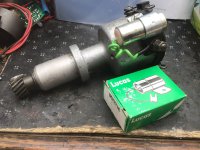The ongoing discussion 
After a friends partially tuned car suffered a breakdown and had to be recovered the breakdown man blamed it on the carb so I got to hear about it pdq as I sold the carb to the guy. I expressed surprise as I said it was by far and away the best condition Panda 30 carb I had ever had my hands on, straight off a low mileage car complete with manifold and head. As Bugsymike says it is often hard to tease out the story of what happened but between two accounts I pieced it together. Car would tick over but was very reluctant to Rev and as the throttle was applied the engine would misfire with associated pops and bangs.
this sounded a familiar story to me but I did some internet research anyway focusing on condenser failures. They can just pack up or often deteriorate over time as the internals break down. One guy had written an extensive thesis on condensers including a forensic analysis of failed ones which he opened up to identify what went wrong. A number of points arose :
1) If you have an old condenser that is working leave it alone.
2) Many replacement condensers are now poor design and manufacture so more prone to failure.
3) Seek out old or original stock where possible with one guy from the US recommending getting used ones from car breakers.
4) The racing spec ones were recommended for reliability but also old Lucas condensers got a high rating.
Still waiting to hear about the broken down car but fingers crossed that a decent condenser saves the day.
Apart from Fiats I have been caught out by condensers on an old Renault 14, back of nowhere in France luckily I had the old one in the boot, also on a Saab when a new one was knackered from the start.
After a friends partially tuned car suffered a breakdown and had to be recovered the breakdown man blamed it on the carb so I got to hear about it pdq as I sold the carb to the guy. I expressed surprise as I said it was by far and away the best condition Panda 30 carb I had ever had my hands on, straight off a low mileage car complete with manifold and head. As Bugsymike says it is often hard to tease out the story of what happened but between two accounts I pieced it together. Car would tick over but was very reluctant to Rev and as the throttle was applied the engine would misfire with associated pops and bangs.
this sounded a familiar story to me but I did some internet research anyway focusing on condenser failures. They can just pack up or often deteriorate over time as the internals break down. One guy had written an extensive thesis on condensers including a forensic analysis of failed ones which he opened up to identify what went wrong. A number of points arose :
1) If you have an old condenser that is working leave it alone.
2) Many replacement condensers are now poor design and manufacture so more prone to failure.
3) Seek out old or original stock where possible with one guy from the US recommending getting used ones from car breakers.
4) The racing spec ones were recommended for reliability but also old Lucas condensers got a high rating.
Still waiting to hear about the broken down car but fingers crossed that a decent condenser saves the day.
Apart from Fiats I have been caught out by condensers on an old Renault 14, back of nowhere in France luckily I had the old one in the boot, also on a Saab when a new one was knackered from the start.



